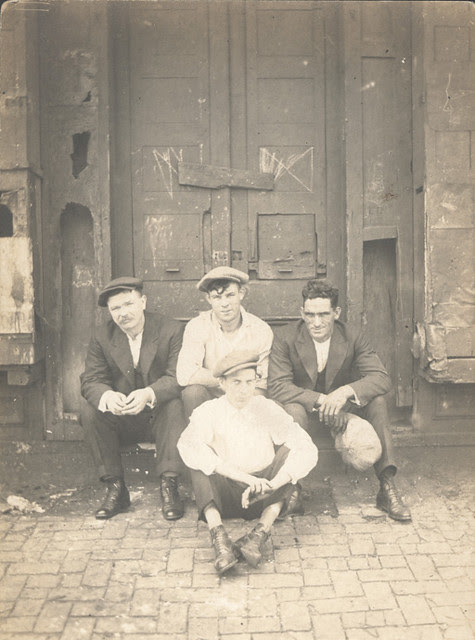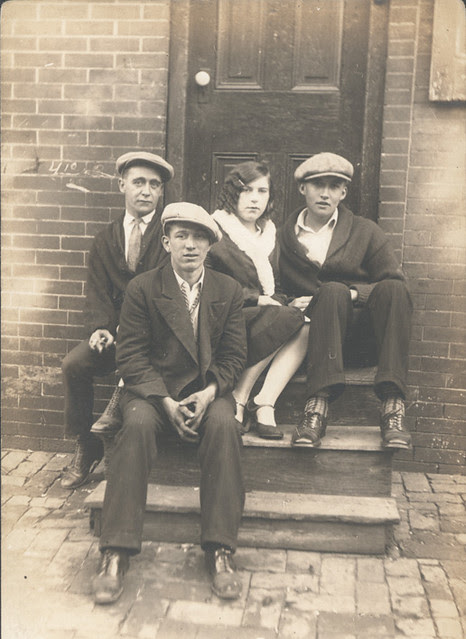
Unidentified subjects, South Philadelphia: photo by John Frank Keith (1863-1947), between 1910 and 1940 (John Frank Keith Collection, Library Company of Philadelphia)

Unidentified subjects, South Philadelphia: photo by John Frank Keith (1863-1947), between 1910 and 1940 (John Frank Keith Collection, Library Company of Philadelphia)

Unidentified subjects, South Philadelphia: photo by John Frank Keith (1863-1947), between 1910 and 1940 (John Frank Keith Collection, Library Company of Philadelphia)

Unidentified subjects, South Philadelphia: photo by John Frank Keith (1863-1947), between 1910 and 1940 (John Frank Keith Collection, Library Company of Philadelphia)

Unidentified subjects, South Philadelphia: photo by John Frank Keith (1863-1947), between 1910 and 1940 (John Frank Keith Collection, Library Company of Philadelphia)

Unidentified subjects, South Philadelphia: photo by John Frank Keith (1863-1947), between 1910 and 1940 (John Frank Keith Collection, Library Company of Philadelphia)

Unidentified subjects, South Philadelphia: photo by John Frank Keith (1863-1947), between 1910 and 1940 (John Frank Keith Collection, Library Company of Philadelphia)

Unidentified subjects, South Philadelphia: photo by John Frank Keith (1863-1947), between 1910 and 1940 (John Frank Keith Collection, Library Company of Philadelphia)

Unidentified subjects, South Philadelphia: photo by John Frank Keith (1863-1947), between 1910 and 1940 (John Frank Keith Collection, Library Company of Philadelphia)

Unidentified subjects, South Philadelphia: photo by John Frank Keith (1863-1947), between 1910 and 1940 (John Frank Keith Collection, Library Company of Philadelphia)

Unidentified subjects, South Philadelphia: photo by John Frank Keith (1863-1947), between 1910 and 1940 (John Frank Keith Collection, Library Company of Philadelphia)

Unidentified subjects, South Philadelphia: photo by John Frank Keith (1863-1947), between 1910 and 1940 (John Frank Keith Collection, Library Company of Philadelphia)

Unidentified subjects, South Philadelphia: photo by John Frank Keith (1863-1947), between 1910 and 1940 (John Frank Keith Collection, Library Company of Philadelphia)

Unidentified subjects, South Philadelphia: photo by John Frank Keith (1863-1947), between 1910 and 1940 (John Frank Keith Collection, Library Company of Philadelphia)

Unidentified subjects, South Philadelphia: photo by John Frank Keith (1863-1947), between 1910 and 1940 (John Frank Keith Collection, Library Company of Philadelphia)

Unidentified subject, South Philadelphia: photo by John Frank Keith (1863-1947), between 1910 and 1940 (John Frank Keith Collection, Library Company of Philadelphia)

Unidentified subject, South Philadelphia: photo by John Frank Keith (1863-1947), between 1910 and 1940 (John Frank Keith Collection, Library Company of Philadelphia)

Unidentified subject, South Philadelphia: photo by John Frank Keith (1863-1947), between 1910 and 1940 (John Frank Keith Collection, Library Company of Philadelphia)

Unidentified subject, South Philadelphia: photo by John Frank Keith (1863-1947), between 1910 and 1940 (John Frank Keith Collection, Library Company of Philadelphia)

Unidentified subject, South Philadelphia: photo by John Frank Keith (1863-1947), between 1910 and 1940 (John Frank Keith Collection, Library Company of Philadelphia)

Unidentified subjects, South Philadelphia: photo by John Frank Keith (1863-1947), between 1910 and 1940 (John Frank Keith Collection, Library Company of Philadelphia)

Unidentified subjects, South Philadelphia: photo by John Frank Keith (1863-1947), between 1910 and 1940 (John Frank Keith Collection, Library Company of Philadelphia)

Unidentified subjects, South Philadelphia: photo by John Frank Keith (1863-1947), between 1910 and 1940 (John Frank Keith Collection, Library Company of Philadelphia)

Unidentified subjects, South Philadelphia: photo by John Frank Keith (1863-1947), between 1910 and 1940 (John Frank Keith Collection, Library Company of Philadelphia)

Unidentified subjects, South Philadelphia: photo by John Frank Keith (1863-1947), between 1910 and 1940 (John Frank Keith Collection, Library Company of Philadelphia)

Unidentified subject, South Philadelphia: photo by John Frank Keith (1863-1947), between 1910 and 1940 (John Frank Keith Collection, Library Company of Philadelphia)

Unidentified subject, South Philadelphia: photo by John Frank Keith (1863-1947), between 1910 and 1940 (John Frank Keith Collection, Library Company of Philadelphia)

Unidentified subject, South Philadelphia: photo by John Frank Keith (1863-1947), between 1910 and 1940 (John Frank Keith Collection, Library Company of Philadelphia)

Unidentified subject, South Philadelphia: photo by John Frank Keith (1863-1947), between 1910 and 1940 (John Frank Keith Collection, Library Company of Philadelphia)

Unidentified subject, South Philadelphia: photo by John Frank Keith (1863-1947), between 1910 and 1940 (John Frank Keith Collection, Library Company of Philadelphia)

Unidentified subjects, South Philadelphia: photo by John Frank Keith (1863-1947), between 1910 and 1940 (John Frank Keith Collection, Library Company of Philadelphia)



5 comments:
John Frank Keith
(March 16, 1883-December 28, 1947)
"John Frank Keith left behind no personal or business records, only his photographs. He never married or had children to pass on his memory. He rarely stamped his photographs with his name and address or left notes on them indicating his motivations. What we know about Keith comes from official government records, accounts from a now-deceased relative, and scattered bits of information pieced together."
And this is what we know.
Beautiful work. Puts me in mind of August Sander. The biography's very moving.
Given the current tiresome plethora of repulsive images of people driven to record over and over the fact that they and their friends are capable of aping foolishly in front of a digital camera, with predictably ugly results, it's hard not to be struck by this honest view of common humanity on its own streets, made at a time when nobody else cared to make such images much less look at them.
The elements of pathos and mystery in the photographer's biography and the commonness, individuality and personality of the subjects make the photos so much more refreshing to approach and rewarding to contemplate than the far better known work of many self-consciously "artistic" practitioners in the field in this period. And the formal constancy of composition and framing, imposed by the conditions of the work, become an important element in the project, further enhancing the impression that, whatever else may be going on, we're not being lied to.
"Keith worked as a bookkeeper in a fish market but spent weekends making photographs. His subjects were invariably the working-class families of Philadelphia's Kensington area. Never asking payment for his pictures, he gave them to the people he photographed.
"Keith's informal archive is more than a collection of individuals: it is an intimate portrait of a neighborhood in the 1920s. Working in a documentary style reminiscent of Lewis Hine, but without Hine's social activism, Keith posed members of the community... on the front stoops of their urban row houses. His inexpensive camera dictated a consistent distance from the subjects, and his amateur-quality lens was responsible for the slightly unfocused distortion at the edge of the picture. Had he stood farther away, the camera's blur would have been too great; standing closer, he would have lost all reference to the neighborhood. Like itinerant photographers of the nineteenth century who counted on the similarities of circumstance and dress to compose a picture, Keith rarely changed the major elements of his photographs. Instead, he focused on the small details that did change: the difference in a door frame or the contrasting colors of shoes worn by two almost identical sisters."
-- Merry A. Foresta American Photographs: The First Century (Washington, D.C.: National Museum of American Art with the Smithsonian Institution Press, 1996)
Tom:
Have you seen the work of Mike Meyer (Disfarmer)?
Interesting portraiture from Kentucky from the first half of the last century.
He was known to be something of a hermit.
Wasn't it Arkansas, actually.
I guess Meyer/Disfarmer and Keith might be categorizable as uncategorizable one-offs. Isolated, each in his own particular way.
But Meyer/Disfarmer had a studio, and worked professionally, albeit in that meagre small-town photo-studio milieu.
And M/D had an aesthetic (yet), a rather strict one at that; it would be difficult to accuse Keith of having such a thing, except in the most ad hoc DIY sort of way.
And we do know a bit about his mind and motives, as is not the case with JFK.
It's his curious renunciation of name and genealogical heritage that would seem to be the place to start with M/D -- psychology. There appear to have been conscious motives, with conceivable histories.
Whereas as far as we know Keith was a blank.
While of course knowing nothing, I must admit to seeing a pathos, in his very blankness, his anonymity -- a lost soul.
Post a Comment